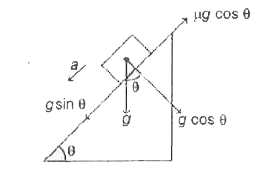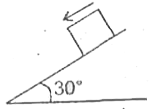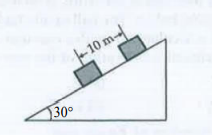A block of mass 10 kg, initially at rest, makes a downward motion on 45∘ inclined plane. Then the distance travelled by the block after 2s is
( Assume the coefficient of kinetic friction to be 0.3 and g=10ms−2)Solution in Telugu
7√2m
9√2m
10√2m
5√2m
The correct Answer is:A
v=u+at
⇒8ˆi+10ˆj=3ˆi+a×8
⇒a=18(5ˆi+10ˆj)m/s2
So, force F=ma
F=48(5ˆi+10ˆj)=12(5ˆi+10ˆj)N
⇒F=12√52+102=5√52N
Hence, the option (a) is correct.

Topper's Solved these Questions
Similar Questions
The pressure on a circular plate is measured by measuring the force on the plate and the radius of the plate. If the errors in measurement of the force and the radius are 5% and 3% respectively, the percentage of error in the measurement of pressure is
02:12View SolutionAssertion (A) The number 0.00764 has three significant figures.
Reason (R ) If the number is less than 1, the zeros on the right of the decimal point but to the left of the first non-zero digit are not significant.01:54View SolutionA block rests on a rough inclined plane making an angle of 30∘ with the horizontal. The coefficient of static friction between the block and the plane is 0.8. If the frictional force on the block is 10N, the mass of the block (in kg) is
02:44View SolutionA block rests on a rought inclined plane making an angle of 30^(@) with horizontal. The coefficient of static friction between the block and inclined plane is 0.8 . If the frictional foerce on the block is 10 N , the mass of the block in kg is (g = 10 m//s^(2))
03:08View SolutionA block of mass 20kg is pushed with a horizontal force of 90N . It the coefficient of static and kinetic friction are 0.4 and 0.3, the frictional force acting on the block is (g =10ms^(-2)) .
04:48View SolutionInitial velocity of the block vecu=45hati while external force on it is vecF=25(-hati) it coefficient of static and kinetic friction are 0.3 and 0.2 respectively then distance travelled by the block in 12 sec (g=10m//s^(2))
07:42View SolutionA block slides down a rough inclined plane of inclination 45^(@) . If the coefficent of kinetic friction is 0.5 , find the acceleration of the sliding block . (g=10ms^(-2)) .
01:58View SolutionIn the figure show below, calculate the coefficient of friction between the block and the inclined plane. Assume that the mass of the block s 1 kg. The block is released from rest and stops by covering the distance of 0.1 m on the plane.
02:52View SolutionA block of mass 10 kg is released on rough incline plane. Block start descending with acceleration 2m/s2. Kinetic friction force acting on block is (take g=10m/s2)
 02:20View Solution
02:20View SolutionA block rests on a rough inclined plane making an angle of 30∘ with the horizontal . The coefficient of static friction between the block and the plane is 0.8 If the frictional force on the block is 10 N the mass of the block is (g=10ms−2)
02:09View SolutionA block of mass 20kg is pushed with a horizontal force of 90N. If the coefficient of static & kinetic friction are 0.4 & 0.3, the frictional force acting on the block is: (g=10ms−2)
09:03View SolutionA block of mass 5kg is lying on a rough horizontal surface. The coefficient of static and kinetic friction are 0.3 and 0.1 and g=10ms−2 The frictional force on the block is
04:21View SolutionA block of mass 0.5 kg has an initial velocity of 10ms−1 down an inclined plane of angle 30∘, the coefficient of friction between the block and the inclined surface is 0.2. The velocity of the block after it travels a distance of 10 m is
 02:42View Solution
02:42View SolutionA block rests on a rough inclined plane making an angle of 30^@ with the horizontal. The coefficient of static friction between the block and the plane is 0.8. If the frictional force on the block is 10N, the mass of the block (in kg) is
02:21View SolutionA block rests on a rough inclined plane making an angle of 30∘ with horizontal. The coefficient of static friction between the block and inclined plane is 0.8 . If the frictional force on the block is 10N, the mass of the block in kg is (g=10m/s2)
01:53View Solution

